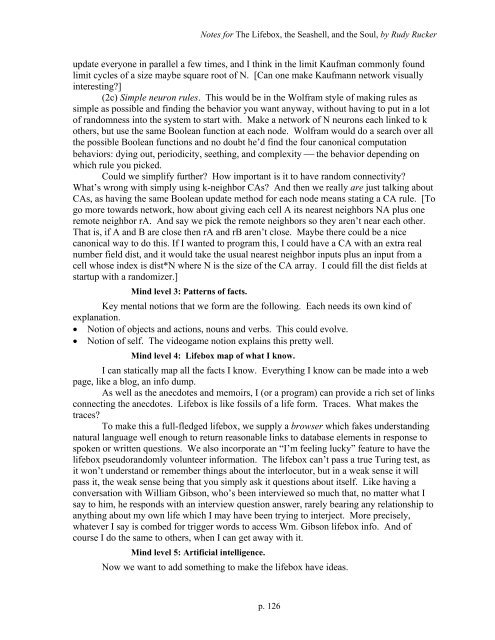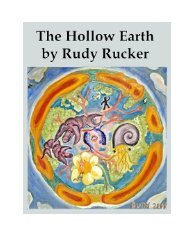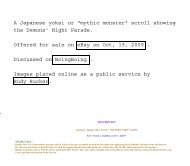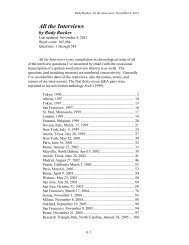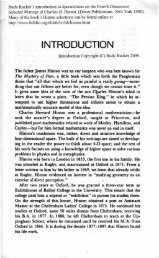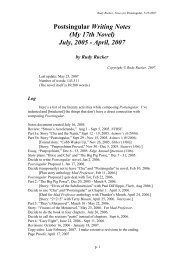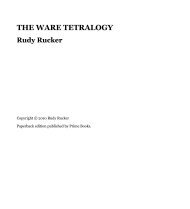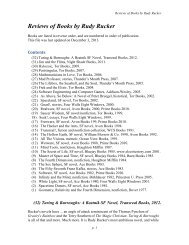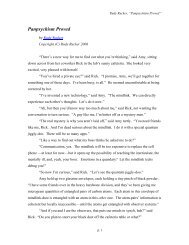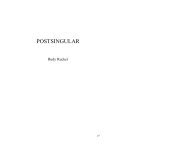Notes for the Lifebox, the Seashell, and the Soul - Rudy Rucker
Notes for the Lifebox, the Seashell, and the Soul - Rudy Rucker
Notes for the Lifebox, the Seashell, and the Soul - Rudy Rucker
Create successful ePaper yourself
Turn your PDF publications into a flip-book with our unique Google optimized e-Paper software.
<strong>Notes</strong> <strong>for</strong> The <strong>Lifebox</strong>, <strong>the</strong> <strong>Seashell</strong>, <strong>and</strong> <strong>the</strong> <strong>Soul</strong>, by <strong>Rudy</strong> <strong>Rucker</strong><br />
update everyone in parallel a few times, <strong>and</strong> I think in <strong>the</strong> limit Kaufman commonly found<br />
limit cycles of a size maybe square root of N. [Can one make Kaufmann network visually<br />
interesting?]<br />
(2c) Simple neuron rules. This would be in <strong>the</strong> Wolfram style of making rules as<br />
simple as possible <strong>and</strong> finding <strong>the</strong> behavior you want anyway, without having to put in a lot<br />
of r<strong>and</strong>omness into <strong>the</strong> system to start with. Make a network of N neurons each linked to k<br />
o<strong>the</strong>rs, but use <strong>the</strong> same Boolean function at each node. Wolfram would do a search over all<br />
<strong>the</strong> possible Boolean functions <strong>and</strong> no doubt he’d find <strong>the</strong> four canonical computation<br />
behaviors: dying out, periodicity, seething, <strong>and</strong> complexity ⎯ <strong>the</strong> behavior depending on<br />
which rule you picked.<br />
Could we simplify fur<strong>the</strong>r? How important is it to have r<strong>and</strong>om connectivity?<br />
What’s wrong with simply using k-neighbor CAs? And <strong>the</strong>n we really are just talking about<br />
CAs, as having <strong>the</strong> same Boolean update method <strong>for</strong> each node means stating a CA rule. [To<br />
go more towards network, how about giving each cell A its nearest neighbors NA plus one<br />
remote neighbor rA. And say we pick <strong>the</strong> remote neighbors so <strong>the</strong>y aren’t near each o<strong>the</strong>r.<br />
That is, if A <strong>and</strong> B are close <strong>the</strong>n rA <strong>and</strong> rB aren’t close. Maybe <strong>the</strong>re could be a nice<br />
canonical way to do this. If I wanted to program this, I could have a CA with an extra real<br />
number field dist, <strong>and</strong> it would take <strong>the</strong> usual nearest neighbor inputs plus an input from a<br />
cell whose index is dist*N where N is <strong>the</strong> size of <strong>the</strong> CA array. I could fill <strong>the</strong> dist fields at<br />
startup with a r<strong>and</strong>omizer.]<br />
Mind level 3: Patterns of facts.<br />
Key mental notions that we <strong>for</strong>m are <strong>the</strong> following. Each needs its own kind of<br />
explanation.<br />
• Notion of objects <strong>and</strong> actions, nouns <strong>and</strong> verbs. This could evolve.<br />
• Notion of self. The videogame notion explains this pretty well.<br />
Mind level 4: <strong>Lifebox</strong> map of what I know.<br />
I can statically map all <strong>the</strong> facts I know. Everything I know can be made into a web<br />
page, like a blog, an info dump.<br />
As well as <strong>the</strong> anecdotes <strong>and</strong> memoirs, I (or a program) can provide a rich set of links<br />
connecting <strong>the</strong> anecdotes. <strong>Lifebox</strong> is like fossils of a life <strong>for</strong>m. Traces. What makes <strong>the</strong><br />
traces?<br />
To make this a full-fledged lifebox, we supply a browser which fakes underst<strong>and</strong>ing<br />
natural language well enough to return reasonable links to database elements in response to<br />
spoken or written questions. We also incorporate an “I’m feeling lucky” feature to have <strong>the</strong><br />
lifebox pseudor<strong>and</strong>omly volunteer in<strong>for</strong>mation. The lifebox can’t pass a true Turing test, as<br />
it won’t underst<strong>and</strong> or remember things about <strong>the</strong> interlocutor, but in a weak sense it will<br />
pass it, <strong>the</strong> weak sense being that you simply ask it questions about itself. Like having a<br />
conversation with William Gibson, who’s been interviewed so much that, no matter what I<br />
say to him, he responds with an interview question answer, rarely bearing any relationship to<br />
anything about my own life which I may have been trying to interject. More precisely,<br />
whatever I say is combed <strong>for</strong> trigger words to access Wm. Gibson lifebox info. And of<br />
course I do <strong>the</strong> same to o<strong>the</strong>rs, when I can get away with it.<br />
Mind level 5: Artificial intelligence.<br />
Now we want to add something to make <strong>the</strong> lifebox have ideas.<br />
p. 126


